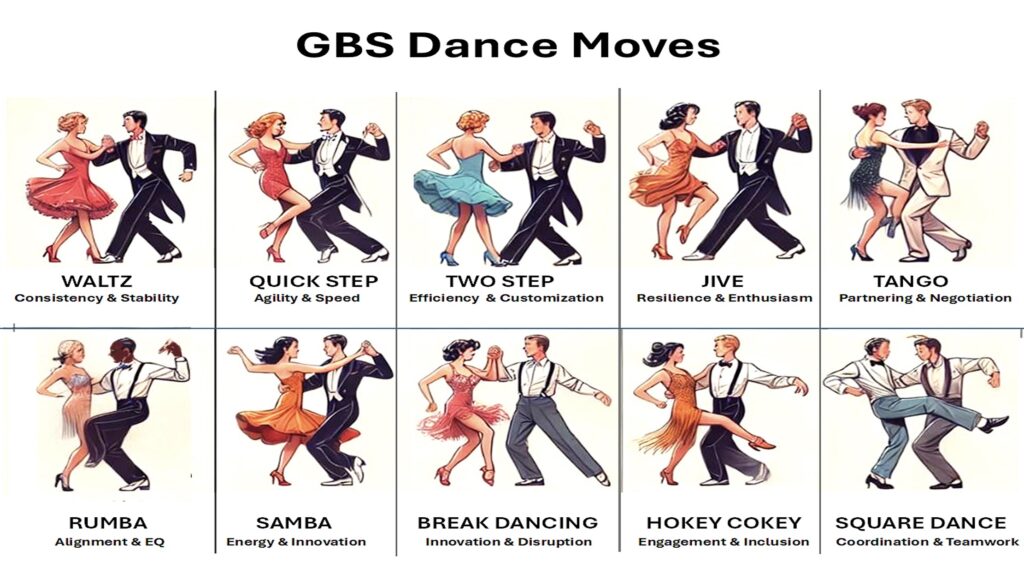
By Deborah Kops
You studied finance, computer science, engineering, general business, or even liberal arts in undergraduate school. You slogged through an MBA. Your employer sent you to leadership courses. You may have even paid for a global business services certification. But I ask you, did you ever think that dance classes were sorely missing in your preparation to take on a GBS leadership role?
When I was growing up, all 13-year-olds were required to take dance classes, gratefully donning white gloves to avoid touching boys who had sweaty hands. We attempted to master the dance moves that would do our mothers proud at proms, weddings, and club dances. We learned etiquette, self-control, and how to avoid looking at a pimply partner. We had to keep our backs straight, coordinate our arms and hands, ensure we had the right footwork, express confidence, and connect with our partners.
Now, it’s far from me to say that being on the show Strictly Come Dancing is the best preparation for a GBS leadership role, but like dancing, GBS is made up of a series of complex, dynamic moves that require its leaders to balance structure, agility, and collaboration—just like a well-executed dance…
You gotta know how to dance, friends. No traditional training will help GBS leaders learn when to glide, when to pivot, and when to freestyle to keep operations running smoothly, keep stakeholders engaged, and deliver business value.
Here are just a few of dances that GBS leaders perform every day (and that the poor tried to get me to master).
Seamless execution
- Waltz – Consistency and Stability The waltz is an elegant but difficult ballroom dance known for its flowing movements, stiff posture, and steady rhythm. GBS leaders must establish a structured, reliable framework that ensures stability while smoothly navigating rapid changes in business conditions. Both a rigid backbone and the ability to transition without much noise are critical.
- Quickstep – Agility & Speed Derivative of the foxtrot, the quickstep is a fast mix of both slow and quick steps and syncopated movements. The quickstep’s rapid footwork mirrors the need for speed and consistency in GBS operations. As business needs shift, leaders must adapt swiftly, ensuring efficiency without missing critical steps in service delivery.
Agility at speed
- Two-Step – Balancing Efficiency & Customization In the two-step, smooth, gliding movements reflect the delicate balance between standardization and customization in GBS. Leaders must maintain consistency in delivery while adapting to unique business needs—when they are warranted.
- Jive – Resilience & Enthusiasm Dancers know that the upbeat, bouncy jive demands resilience—just like GBS must quickly recover from setbacks, maintaining energy and momentum in a constantly shifting business environment.
Constructive relationships
- Tango – Strategic Partnering & Negotiation The tango is a passionate and dramatic dance that requires strong coordination between partners, and measured emotion. Likewise, GBS leaders engage in strategic negotiations, working closely with business stakeholders to align goals and drive value.
- Rumba – Alignment & Emotional Intelligence Rumba’s slow, sensual movements emphasize connection—just as strong GBS leadership relies on building deep relationships with employees, customers, and partners to ensure long-term success.
Innovation at pace
- Samba – Energy & Continuous Innovation A lively, rhythmical dance of Afro-Brazilian origin, samba symbolizes the fast-paced, high-energy nature required of successful GBS organizations. Leaders must embrace continuous transformation, integrating automation and digital capabilities while constantly keeping operations agile.
- Breakdance – Innovation & Disruption Breakdancing’s acrobatic moves represent the disruptive thinking required to modernize GBS. Leaders must challenge traditional processes and drive digital transformation to stay competitive—and not be afraid to try something new.
Consistent coordination
- Hokey-Cokey – Engagement & Inclusion This simple, participatory circle dance ensures everyone is involved—with movements more or less in synch—just like GBS thrives on collaboration and inclusion across teams and geographies. GBS organizations succeed when everyone is moving in the same direction at the same time.
- Square Dance – Coordination & Teamwork With multiple dancers responding to a caller, the square dance represents the coordination GBS leaders need to align global teams, shared services, and stakeholders for seamless execution. The business, not GBS, ultimately calls the shots.
Need I continue to pound the metaphor home? A successful GBS leader must be a versatile dancer—graceful like the waltz, agile like the quickstep, and innovative like breakdancing. They must be inclusive like the hokey-cokey, coordinated as a square dance, and strategic like the tango.
So, what’s your next move? Are you ready to dance your way to GBS success?